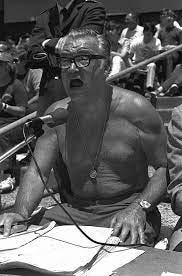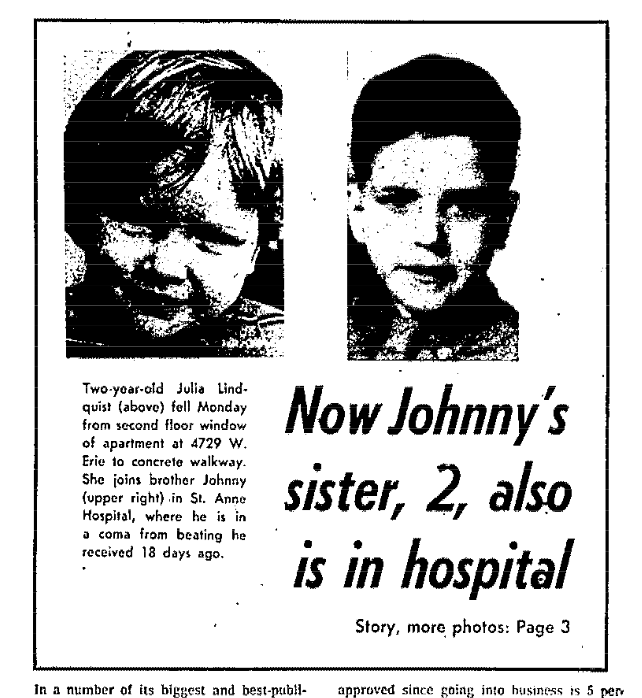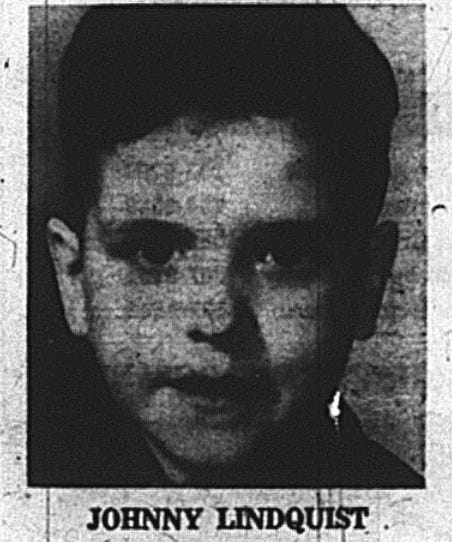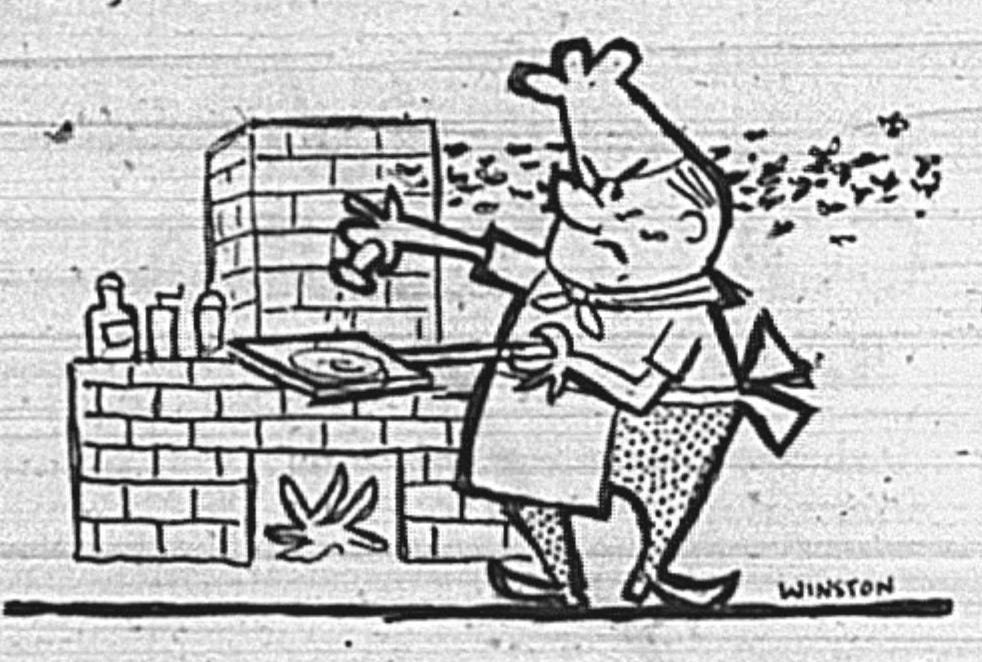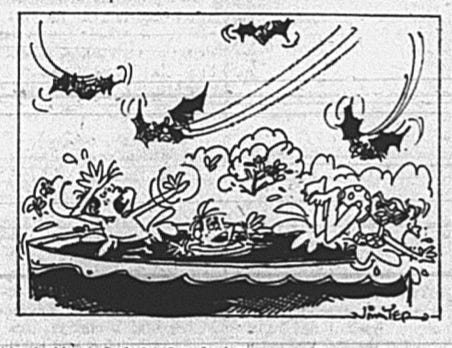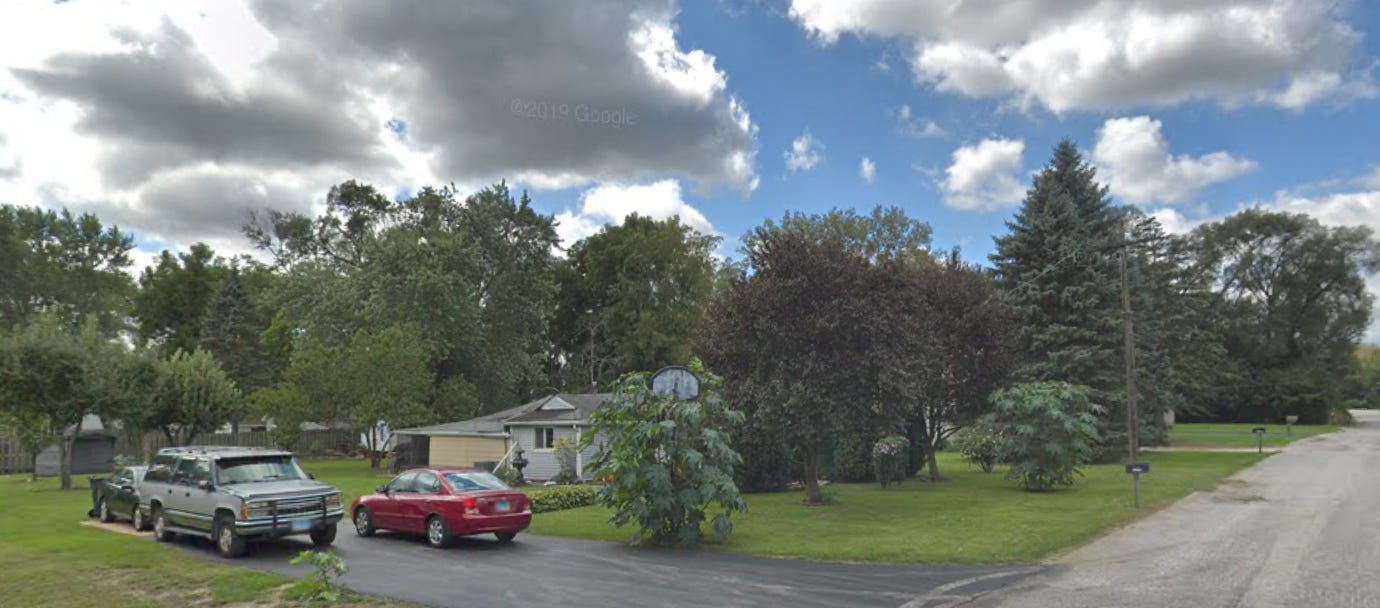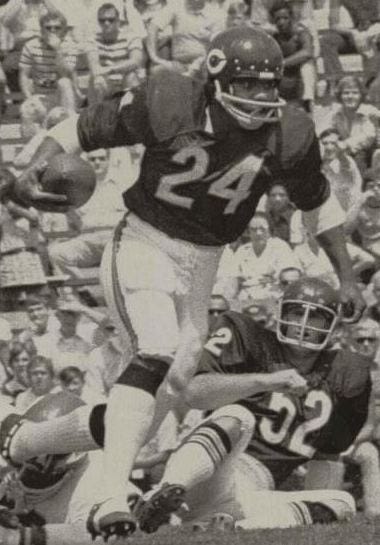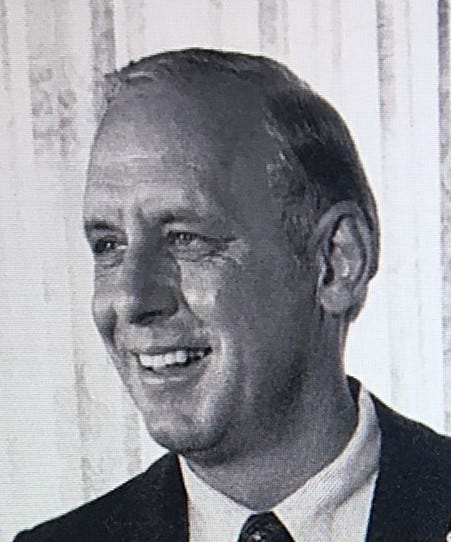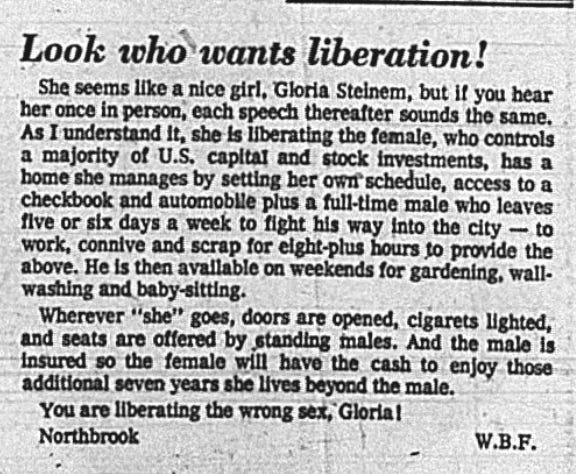To access all site contents, click HERE.
Why do we run this separate item peeking into newspapers from 1972? Because 1972 is part of the ancient times when everybody read a paper. Everybody, everybody, everybody. Even kids. So Steve Bertolucci, the 10-year-old hero of the novel serialized at this Substack, read the paper too—sometimes just to have something to do. These are some of the stories he read. Follow THIS CRAZY DAY on Twitter, @RoselandChi1972.
August 14, 1972: Bud Billiken
Chicago Daily Defender
Lower righthand picture—Shinnette Smith and Vernon Bey are crowned King and Queen of the 43rd annual Bud Billiken Parade by Gary Mayor Richard Hatcher!
August 14, 1972
Chicago Today
This is the first Phil Donahue ad I’ve seen, and that’s because it is the first one in 1972 in any of the papers. Phil got a try-out in the big markets in 1971 that didn’t work out so well—but he’s getting a second chance.
Here’s Phil’s original Chicago premiere listed in the September 11, 1971 Daily News TV Guide. Imagine, Phil Donahue airing at midnight!
Phil only got this one promotional ad out of Channel 5 in his first run:
By January 18, 1972, Daily News TV columnist Norman Mark was writing:
David Frost replaced Phil by March, 1972.
On July 18, however, Norman Mark—now with his more familiar column logo—revealed Phil’s future in Chicago:
Today’s ad for Barbara Walters and Phil at the top of this item began running in Chicago Today and the Sun-Times. Tomorrow it will appear in the Tribune.
I think this Phil Donahue guy just might catch on this time.
August 14, 1972: Corbett murders
Chicago Tribune
no byline
“A gun found in a Barrington Hills creek by two Scuba divers may be a major breakthru in the investigation of the Aug. 4 slayings of a retired insurance executive and three members of his family, the police hoped yesterday,” writes the Tribune in an unbylined article.
“Barrington Hills Police Chief Ralph Hummel said that the weapon was found Saturday in Spring Creek, about 50 feet south of Lake-Cook Rd., about half a mile from the murder scene,” per the Daily News’ John Gallagher. The creek is about three feet deep in this area.
Did you miss the beginning of the stunning Barrington Hills murders? Read the initial coverage here and here from the first two days after four members of the Corbett family were found executed in their mansion’s pantry.
The first clues were examined here, along with a look at Barrington Hills itself; then we learned of the discovery that someone had talked to Paul Corbett on the phone that night while he almost certainly had a gun to his head.
At the end of this week’s TCD1972, the Sun-Times’ Art Petacque will review the case so far.
Chicago Daily News
by John Gallagher
A local motorist told police they saw someone throw something into Spring Creek, from a blue-panel truck with two occupants, right about the time of the murders, Chief Hummel told reporters.
“Such a vehicle was seen and heard near the murder scene on the night of the killings,” the News’ Gallagher adds. How do we know? Because of the bucolic, residential nature of Barrington Hills. Unlike where you may live, it’s unusual for a truck to drive through the neighborhood. So when a truck rumbled through on the night of August 4, people remembered and told the police about it.
Still, the Tribune notes that the blue-panel truck driven by somebody who threw something in Spring Creek that night is not the “stolen blue-panel truck found abandoned near Aurora shortly after the slayings.” That truck was “stolen from a restaurant about three miles from the Corbett home.” It’s unclear how they know it’s definitely not the same truck.
Chief Hummel wouldn’t reveal what type of weapon was recovered from Spring Creek. Three members of the Corbett family were shot in the head with a .25 caliber pistol, and one was shot in the heart by a .30 caliber rifle.
Whatever it is, the gun has been in the creek for a week now, but the Chicago Crime Laboratory still hopes to recover prints.
August 14, 1972: White Sox
Chicago Daily News
“It’s ga-ga time again for the go-go White Sox.
“The Sox returned home Sunday night a game out of first place, but that didn’t deter 1,000 cheering fans who turned out to greet their heroes at O’Hare Airport. All were confident that the Sox are on the trail of the American League pennant that has eluded them since 1959.”
The Sox “trouped off” the plane at 11 p.m., led by Harry Caray.
“‘This is just great for the players,’ manager Chuck Tanner said as he fought his way through the crowd to his luggage.”
Cab driver Edward Daniels and his unnamed wife and son, from 6831 S. Elizabeth in Englewood, were there.
“They’ve been doing a heroic job,” Daniels told the News’ Robert Schenet. “This is just our way of showing our appreciation, and inspiring them to go on and take the pennant.”
Daily News: Dick Allen at O’Hare
August 14, 1972: Lindquist case
Chicago Daily News
by James Bowman and Barry Felcher
This is front page news. Six-year-old Johnny Lindquist has been in a coma and on or near the front pages of all four major dailies since his biological father savagely beat him on July 28, after torturing Johnny repeatedly by tying him up with a clothesline and hanging him upside down over a door for days at a time.
Chicago Today broke Johnny’s tragic story on August 1. Chicagoans have read about Johnny daily as his face became a familiar sight on front pages August 2, August 3, and August 4. The following week, Chicago Today reporters visited the Lindquist apartment at 4729 W. Erie and tried to speak with Mrs. Lindquist on August 7 and August 10. Instead, they got an earful from her sisters-in-law and gave Johnny’s siblings some candy. On August 8, we got our first look at William Lindquist, the man who put Johnny in a coma—and he could play Charles Manson. Lindquist is in jail now, awaiting trial.
A brief recap: Johnny Lindquist was sent to an orphanage immediately after birth and grew up entirely in loving foster homes. He’d spent the last 3 1/2 years, more than half his short life, living happily with the Karvanek family. The Karvaneks moved from Chicago’s Southwest Side to a farm in Wisconsin so Johnny and his foster brother could fish and ride a pony. But DCFS sent Johnny back to his natural parents and his four biological siblings anyway in March—without a court order. They wouldn’t even let Johnny take his favorite toy with him, a G.I. Joe.
In today’s Johnny Lindquist news, we get our first look at the two-story house at 4729 W. Erie. The Lindquists moved into the second floor apartment on July 28, the day William Lindquist beat Johnny into a coma. In 2022, that site is a vacant lot.
“The 2-year-old sister of Johnny Lindquist plunged through a second-floor window Monday and landed on a sidewalk among broken beer bottles,” reports the Daily News.
“Julia Lindquist, who suffered multiple lacerations, was admitted to St. Anne’s Hospital, where Johnny, 6, remains in critical condition.”
Mrs. Irene Lindquist was asleep.
An emergency court hearing took custody of all the Lindquist children a few hours later. Finally.
The other papers follow up the next day, August 15. From the Sun-Times front page:
The story inside by Paul Galloway follows the reporter as he spends the morning at the Lindquist’s chaotic second-floor apartment, observing police take pictures of the room in which 2-year-old Julia fell out the window. Johnny’s two young brothers, 5-year-old Jimmy and 3-year-old Joseph, run around. Johnny’s 8-year-old sister is at a summer camp.
“It did seem incredible that another tragedy had struck another Lindquist child,” writes Galloway. “But a visit to the family flat made the nightmare more believable.”
Patricia Strong, the sister-in-law who lives downstairs, points out the broken beer bottle pieces on the sidewalk next to the house, where Julia fell. Strong tells Galloway she was home that morning around 9:45 a.m. when her own 5-year-old ran inside and said, “The baby fell out the window.”
Strong says she picked up Julia, wrapped her in a blanket, and called police. Then she stayed outside to tell reporters like Galloway that she had babysat the Lindquist children the night before while her sister-in-law went out drinking with friends.
In another version later, she will say Irene Lindquist was out drinking with her sister. Her sister will write to the paper insisting she was not drinking with Irene, and has nothing to do with her.
“She got home about 4:30 in the morning (Monday) and she didn’t seem so drunk,” says Mrs. Strong.
Galloway follows Patricia Strong and the police up to the Lindquist apartment.
“Two dogs, Frisky and Lady, were yelping in a back room. In the kitchen, water had run from a sink and covered the floor and splotches of catsup were on the floor….Investigators looked at the dining room window, which was open about 13 inches. Directly beneath, an estimated 25 feet, was the walkway and the broken glass surrounds by empty beer cans.
“There was no screen on the window.”
….. “On the dining room table were a full quart bottle of beer, a leather belt, an ashtray holding flashbulbs already used by the police to photograph the scene and a white vase with a plastic flower in it.”
Mrs. Strong and the police get the kids changed out of “catsup-stained” clothes, put shoes and socks on them, and take them to the waiting squad car.
“‘We’re going to take a ride now,’ Patrolman Kenneth Cain, of the Austin District tells Jimmy. Cain and his partner, Patrolman John Seidel, had already taken Julia to the hospital. Now it was time to take Jimmy and Joseph to an emergency custody hearing. Seiser carriesa crying Joseph out to the squad car.
Galloway follows everyone to Juvenile Court and watches Judge William Sylvester White put the Lindquist kids into temporary custody.
“Mrs. Lindquist stood before the judge, sobbing and holding her hand over her face. On a bench with juvenile officers, Jimmy ate a ham and cheese sandwich and drank from a paper carton of chocolate milk, not understanding what was happening.”
The Daily News’ Ellen Warren and James Bowman cover the Lindquist developments for August 15 and describe the end of the court hearing this way:
Irene Lindquist told the court she came home about 5 a.m. and was asleep when Julia fell out the window. No mention of who she was drinking with, apparently.
“If two of them [Lindquist kids] are in St. Anne’s Hospital right now, how many more does it take?’” asks Asst. State’s Attorney Maurice Dore, arguing for taking custody away from Mrs. Lindquist.
“Neither James nor his brother Joseph, 4, appeared concerned with Monday’s court hearing until after their mother left the court without comment,” writes the News’ Warren and Bowman.
“‘Where’s Mommy going?’ Jimmy asked. And then, ‘I want to go back to our house.”
August 15, 1972: Dick Allen Watch
In case you can’t read that picture caption, it says “Mr. Sox, Dick Allen, and Mr. Cub, Ernie Banks, get acquainted before benefit game.”
It’s the “annual mid-season” Cubs-Sox exhibition game, and the Cubs “won on a fourth-inning homer by Billy Williams”.
But it was Ernie Banks, writes Jerome Holtzman, who got two standing ovations. Ernie is a Cubs coach now, so it was a real treat for fans to see him play “the last three innings at first base as a replacement for Joe Pepitone.”
Play had to be held up for the ninth inning standing ovation for Ernie.
“Richie Allen and Carlos May, the big thumpers for the White Sox, made token appearances. They played one inning, with each having one time at bat. Richie got a single to center but May struck out and into a double play as Richie [got] caught trying to steal second.”
The papers still can’t figure out whether to call him “Dick Allen” or “Richie Allen.”
Did you notice the second front sports page story?
Chicago Sun-Times: Gale Sayers
by Jack Griffin
For Bears fans, this is the story that hurts to read.
Veteran columnist Jack Griffin, writing from Bears training camp in Rensselaer, Indiana, reports:
“Gale Sayers tiptoed gingerly into camp for the first time this year, took a light morning exercise and was excused from the afternoon tilt.
“Head coach Abe Gibron explained that he wanted Sayers thoroughly examined by Dr. Ted Fox, the team physician, before Gale was exposed to the rough-and-tumble type of camp Abe is running.”
But Griffin sees Sayers is limping on his left leg.
“Sayers, who has had five operations on his knees in less than four years, has been working in Chicago trying to regain some of his old strength and agility.”
Beloved Bears star Gale Sayers, the Kansas City comet now played by Billy Dee Williams in “Brian’s Song,” has only played in four games in the last two years, carrying the ball just “36 times for 90 yards, an average of 2.5 yards a rush.”
August 15, 1972
Chicago Today: Debbie Ward
by Jack Queeney
“The 16-year-old daughter of a Chicago police sergeant risked her life yesterday to save a 12-year-old girl who had jumped into Lake Michigan near the Fullerton Avenue beach.
“Debbie Ward, an asthmatic, and two girl friends were sunning themselves on the rocks near Fullerton Avenue and saw Gensie Caldwell, of 926 Concord Pl., jump into the water.”

“‘The area is off limits for swimming and very dangerous,’ Debbie said. ‘I could see the girl couldn’t swim too well, so I asked some of the kids nearby if she knew how to swim.’”
The others said Gensie was fine, but soon they were calling for help. Several lifeguards responded and dove in search of Gensie, to no avail. So Debbie dove in too.
“I then dove into the water and went all the way to the bottom, looked around, and spotted her yellow shirt. She was wedged between the rocks and out completely.’”
Debbie brought Gensie back up, and the lifeguards performed mouth-to-mouth resuscitation before a Fire Department ambulance arrived to take Gensie to nearby St. Joseph Hospital, where Gensie is in critical condition.
August 15, 1972: Debbie Ward
Chicago Daily News
“Miss Ward, who has asthma, said she had no difficulty breathing during the rescue attempt, although she does ‘occasionally.’ Asked whether she would do it again, she said, ‘Yes. I didn’t care who she was. I’d never seen her before.”
“Debbie’s father, John, is a sergeant with the Maxwell Area Auto Theft Unit. He told The Daily News that he and his family ‘all feel proud of Debbie. She did a courageous thing, but we wish the little girl had lived.’”
I’d love to know what Debbie Ward is doing these days. She was a junior at Immaculata High School when she dove into 12 feet of water to save a stranger. And, of course, I wish Gensie Caldwell had gotten to grow up.
August 15, 1972: Corbett murders
Chicago Tribune
no byline
Never mind about that gun somebody threw in Spring Creek the night of the Corbett murders. It’s not the right caliber.
But what a weird coincidence.
If you’re a regular THIS CRAZY DAY reader, you’ll probably want to follow Mike Royko 50 Years Ago Today too.
August 15, 1972: Lindquist case
Chicago Today
by Howard Marks
“Physical abuse by his natural parents forced the state to remove Johnny Lindquist from his [biological parents’] home after a three-month trial stay between August and November 1968, CHICAGO TODAY has learned,” is Howard Marks’ explosive lede in the latest chapter in the Johnny Lindquist story.
“The information was contained in documents which were suppressed by the Department of Children and Family Services because of the unfavorable publicity they might generate.”
Accord to “the secret report,” Johnny had to be taken away from the Lindquists because “the boy’s body was so covered with bruises from the beating he received from his father and mother that the trial visit was terminated….The report noted that Johnny’s parents said they were angry at him for bedwetting.”
Per Today, “Reliable sources say [DCFS] asked Alfred M. Kuzel, director of the legal section of Juvenile Court, to refrain from reading the documents into the record at a court hearing last week.”
DCFS was unavailable for comment.
August 16, 1972: Lindquist case
Chicago Daily News
by Ellen Warren and Diane Monk
More on that suppressed report about 6-year-old Johnny Lindquist, because Judge Thomas Rosenberg gave it to the Daily News.
Rosenberg says the report “exonerates” him of blame for the fact that Johnny was taken from his loving foster home and returned to his biological parents, William and Irene Lindquist.
As Chicago Today revealed yesterday, though this would never be mentioned by a competing newspaper like the Daily News, the suppressed report says the Lindquists beat Johnny during a three-month trial visit in 1968, so “said minor was covered with bruises and scars inflicted by both parents.”
“Nobody has yet admitted making the mistakes that may cost Johnny Lindquist his life, but mistakes were clearly documented in a report now on file in Juvenile Court,” Warren and Monk report.
Per this story, Johnny’s current court guardian, Alfred M. Kuzel, wanted to file the report before a hearing last Friday, but Chief Juvenile Court Judge William Sylvester White asked him not to.
“White won’t say why he wanted the report suppressed. When he was asked directly whether [DCFS] asked him to keep the report secret, White replied, ‘No answer.’”
Perhaps the phrase “no comment” hadn’t been invented yet in 1972.
The Lindquists first asked for Johnny back in 1970, but the court refused and kept Johnny with his foster parents, the Karvaneks, during four continuances—the last one on Feb. 25 by Judge Rosenberg. The next hearing to consider whether to send Johnny back to the Lindquists was supposed to be August 4, but instead, Catholic Charities took Johnny away from the Karvaneks and brought him to the Lindquists on March 28, without any court order.
“Between Feb. 25 and March 28, Johnny’s Catholic Charities caseworker didn’t pay any visits to William and Irene Lindquist, according to [Judge] Rosenberg,” who says he was told this in a meeting with Judge White this week.
August 16, 1972: Bud Billiken
Chicago Daily Defender
August 16, 1972: Skyjacked
Chicago Sun-Times
by Art Petacque
“The government has grounded virtually all the sky marshals who were detailed to halt airplane hijackings, their chief confirmed Tuesday.
“Lt. Gen. Benjamin O. Davis said the marshals now are assigned primarily to gate checks of passengers and other screening procedures at airports.”
“Flying marshals are of limited value once a skyjacking takes place in the air because of the danger to passengers of an airborne gun battle or other violent action by the skyjacker” according to a “source.”
“The Air Transportation Assn. reported Tuesday that 16 of 17 attempts at skyjacking for ransom have failed so far this year, with the skyjackers being either arrested, killed or held by a foreign government.”
But…there have been 17 U.S. skyjackings already in 1972. Whether the skyjackers got away with the cash or not, 17 sets of plane crews and passengers went through a skyjacking.
In 1971, there were 25 for the whole year.
August 16, 1972: Antiskyjacking measures
Chicago Today
by Michael Hirsley
“Aviation officials believe that efforts to prevent hijackings are beginning to work,” writes Hirsley. “After a rash of airplane hijack attempts in the United States this year, there has not been one in August.”
Note: That’s a low bar, and only true by a single day.
The most recent U.S. hijacking occurred July 31, when a group identifying themselves as Black Panthers—composed of three men, two women and three kids—hijacked a Delta DC-8 in Detroit and took a $1 million ransom with them to Algiers.
The last we heard in the papers on August 3, those hijackers were being held by the Algerian government; the group of exiled Panthers in Algeria including Eldridge Cleaver said they didn’t know the hijackers; and the U.S. is hoping to get the money back.
Nonetheless, FAA spokesmen say things are better now due to three tighter security measures:
80 countries signed an agreement to extradite skyjackers and return ransoms. Unstated: Nobody knows what’s going to happen with that $1 million in Algiers.
“Rear exits have been sealed on 727, DC-9, and BAC-111 planes, which have been used by parachutist hijackers. Parachuting from any other exit is considered suicidal.”
Airlines are supposedly “embarrassed” and so taking their own security procedures more seriously. (It’s up to airlines to search passengers or baggage, or ask for identification.)
Plus, the FAA claims the federal government is finally going to provide $3 million ($20 million in 2022) for metal detectors.
O’Hare is allegedly the first airport in which airlines are using metal detectors to search luggage, per this FAA spokesman. Elsewhere in 1972 Chicago papers, we’ve only heard of Eastern Air Lines, at O’Hare, having and using metal detectors.
Meanwhile, as Art Petacque wrote in the Sun-Times, the Air Marshals who began flying anonymously in 1970 have been grounded. The FAA paints this as a positive measure, but admits there is a “troublesome” development: the changing profile of a typical skyjacker.
Skyjackers used to be “mostly political revolutionaries and mentally unstable people,” in earlier skyjacking days, from 1968 to 1970. But now they’re extortionists.
Anonymous FAA spokesman: “We thought we were getting good profiles when we started finding more and more knives and pistols tossed into garbage cans at the airport.”
But now they have to develop new profiles of potential skyjackers.
This is the record that the FAA touts as a win: 29 people have skyjacked planes for ransom since Nov. 24, when D.B. Cooper jumped out of a plane near Reno with $300,000. But all 19 subsequent skyjackings “failed as far as getting away with the money was concerned”.
August 16, 1972
Chicago Daily Defender: Service Federal Savings ad
Service Federal Savings is coming up with an array of ads on this theme—we saw another on August 5-6.
August 16, 1972: Corbett murders
Chicago Daily News
by Barry Felcher
Two brothers gave Chicago police “the names of three men whom the brothers said took part in the murder” of four members of the Corbett family in posh Barrington Hills, on August 4. Cops are looking for the fingered men now.
“James Egan, 29, and his brother, John, 25, both of 6501 S. Artesian, told police that they knew ‘something about the Barrington Hills killings’” after they were caught Tuesday night looting a garage, with a stolen car parked nearby.
Although the Daily News gave this the biggest headline you can get—above the masthead—when the story jumps inside, we read this:
“John Killackey, chief of the Chicago police Criminal Investigations Division, said that police had serious doubts about the story told by the Egan brothers.
“Killackey said that the brothers had agreed to take lie detector tests late Wednesday in the Chicago police crime laboratory at 1121 S. State.
“Killackey said that police made an attempt to give the brothers lie tests early Wednesday, but had to cancel them because the brothers had been drinking prior to their arrest.
“James Egan said he was unemployed and John Egan said he was a laborer for a construction company.
“Lt. Robert Randall of the Chicago Lawn District tactical unit said that the two brothers apparently began talking about the Barrington Hills slayings because ‘they wanted to make a deal’ to obtain lenient treatment.
“Randall added, ‘They asked the arresting officers if they would see to it that they got off on this thing (the garage burglary and auto theft) if they talked about Barrington Hills.’”
Q: Are these guys the comic relief on an episode of “Law and Order”? Answer next item.
August 17, 1972: Corbett murders
Chicago Today
no byline
A: Yes.
“Two brothers who told police they knew the killers of four persons in Barrington Hills have refused to take lie detector tests and now say they were drunk when they first talked to police,” Chicago Today reports.
The drunk Egan brothers were arrested behind the garage they were burgling behind 7818 S. Sawyer on Tuesday night.

“They were found hiding behind a stolen car which had its engine running, police said, and a tool box and golf bag from the garage had been placed inside the car.”
Recall that the Egans initially claimed to be able to name three men who had murdered four members of the Corbett family in their posh Barrington Hills mansion on August 4, in a scene described by police as “a slaughterhouse,” in exchange for getting off on the burglary and car theft charges.
They volunteered to take a lie detector test.
“The tests were postponed until late last night to let the Egans sober up,” per Today.
“Bond on James was set at $10,000 and on John at $13,000 by Associate Circuit Judge Joseph R. Schwaba. Neither brother was able to make bond.”
We will not hear from the Egans again. The most disappointing part is that there are no mug shots.
But, because Google Streetview was obliging enough to drive down the alley, here is the garage the Egan brothers broke into.

Chicago Tribune
The Tribune adds: “Police have so far uncovered no worthwhile clues to the slaying of Paul Corbett, a retired insurance executive, 68; his wife, Marian; her sister, Mrs Dorothy Derry, and Mrs. Corbett’s daughter by a previous marriage, Miss Barbara Boand.”
So much for yesterday’s giant above-the-masthead headline in the Daily News.
August 17, 1972: Lindquist case
Chicago Daily News
by Ellen Warren
“A Catholic Charities official Thursday admitted that the agency went ahead with plans to return Johnny Lindquist to his parents even though it was aware of reports they had beaten him,” the News’ Ellen Warren reports.
“Msgr. Thomas J. Holbrook, director of social services for the agency, said, however, that ‘there was never any indication that there was anything untoward as far as abuse of the child.”
Msgr. Holbrook held a joint press conference with DCFS executive deputy director Merle Springer to “clarify what they termed ‘misinformation’”.
Warren reports that Holbrook repeatedly evaded answering who actually made the decision to take Johnny Lindquist from his loving foster home and send him back to the Lindquists, despite their record of child abuse, and without a court order from Judge Rosenberg.
Even though Holbrook admitted that the Catholic Charities social worker set Johnny’s return date. He admitted no psychiatric examination was ordered for the Lindquists before returning Johnny to them, either.
“He also admitted that no social worker visited or interviewed the Lindquists between the times of the last court hearing and the boy’ actual arrival at their home.”
And yet, Msgr. Holbrook said Catholic Charities, DCFS, Family Court and Judge Rosenberg deserved “no blame whatsoever” for the massive mistake that resulted in Johnny’s current vegetative coma.
Ellen Warren, by the way, was one of Mike Royko’s first “legmen” at the Daily News, after starting out at City News Bureau. She went on to a distinguished career for the Sun-Times after the Daily News folded, then with the Tribune, retiring there in 2014.
Warren “may hold the record for having written the widest variety of columns during her tenure at the Tribune” wrote media columnist Robert Feder when Warren retired. Besides “Answer Angel,” he wrote, Warren wrote columns on “metro, lifestyle, politics, magazines, shopping advice and the INC. celebrity gossip column, which she co-wrote with Teresa Wiltz and the late Terry Armour.”
August 18, 1972
Chicago Daily News: Mosquitoes
by Phillip J. O’Connor
Last week, reporters descended on Barrington Hills to churn out straight news stories about the awful murder of four members of the Corbett family. But every paper also sent a reporter to do an atmosphere story, and besides the lush bucolic landscape, the big houses, and the neighbors passing by on magnificent horses, the atmosphere featured something else: Mosquitoes.
For the Sun-Times, Mike Miner stood at the top of the steep hill where the Corbett mansion nestled among 30 acres of trees, and described watching a father and daughter ride their bikes up the road to look at what was being described as “the murder house”:
“An older man, apparently her father, had pedaled as far as the first house on the right—a gray brick house set well back in a wooded lawn—and he waited for the girl to catch up. Mosquitoes dropped to his arms.”
Later, Miner headed downhill to neighbor Fred Pollak’s mansion:
“Fred Pollak sat by his pool Saturday under a red umbrella and slapped at mosquitos.”
Phillip J. O’Connor explains why mosquitoes are showing up in the newspaper lately, complete with cute cartoon.
“The Chicago area is having its worst mosquito invasion in modern times, officials of three mosquito treatment districts said Friday.
“The record crop, totaling in the billions, is the result of Chicago’s unusually wet summer weather, officials said.
“‘The skyrocketing mosquito population has caused the more ferocious woodland type of mosquito to invade residential areas,’ said Calvin Alvarez, manager of the Des Plaines Mosquito Abatement District”.
The heads of several abatement districts agree the mosquitoes are the worst they’ve ever seen. There are so many, they’re coming out of the woods to feast on suburbanites. And they’re swarming out of those woods all day long, not just at dusk.
Plus, the record number of mosquitoes—they mate before they can even fly, each acre of water produces a million or more mosquitoes, and each female lays up to 300 eggs—has attracted a record number of bats. The Daily News ran an article yesterday with its own cute cartoon about suburbanites from all directions terrorized by the flying rodents. Apparently writing about the bats yesterday made the Daily News realize they should write about the mosquitoes today.
Phillip J. O’Connor did the bat story too.
“Low-flying bats are zooming about more than 20 suburbs, from posh Lake Forest on the north to Markham on the south, causing a flutter among residents,” writes O’Connor.
The bats have “struck terror” into the Krenkel family at 3823 W. 154th in Markham, where Mrs. Krenkel says the bats swoop in so low over the swimming pool that you can reach up and grab them—if you wanted to, which she doesn’t. She would like the Cook County Rabies Control Office to get rid of the bats, regardless of whether they can find any evidence of rabies. She’d like them to cut down a nearby old willow where she thinks they live, due to the squeaking.
“A rabid bat was killed July 30 in a fight with a pet dog in Lake Forest. The dog was destroyed. The Lake Forest bat was among 43 bats submitted to the Illinois Department of Health’s laboratory here during the period from July 1 to Aug. 15. It was the only one found to be rabid.”
Two people got bitten by bats in Chicago in 1971, but none so far this year.
August 18, 1972: More mosquitoes
Chicago Sun-Times
Veteran sports columnist Jack Griffin describes the scene at the Bears’ long-time training camp in Rensselaer, Indiana, where they bunk, study and practice at tiny St. Joseph’s College—and hold an annual outdoor feast at a nearby park. According to Griffen, “it takes the little park a year to recover.”
“There were three lambs of 40 pounds each roasting on the spits, and a pig that went 200. The field had been stripped of more than 200 ears of corn, and there were 60 pounds of flaming sausage.
“Don Shy appointed himself master of ceremonies….The rookies were summoned to sing the Bear fight song”—a strict tradition— “but it was not with the proper fervor, and they were hooted and hollered back to their bench”—another tradition.
“A mosquito came in to scout the party for all his millions of comrades, but Dick Butkus swatted him for a 15-yard loss. The fellow staggered back to his people, and told them to stay the hell away from that party. ‘These people played rough!’
“Abe Gibron came on and sang ‘Yankee Doodle Dandy’ all the way through…
…and did a soft shoe dance across the green grass. And that truly opened the party up.”
“Ed McCaskey did some stuff from the big band days, and Mugsy Halas sang ‘Paper Doll.’ And when he was through he threw his arms out wide, and promised everybody a $20,000 raise.
“Wait until his old man hears about that.
“Then Zeke Bratkowski’s boy, Steve, came on and broke up the park with imitations of Butkus, Bobby Douglass, and an injured Shy, and a poor Ronnie Smith.”
“There was a chug-a-lug contest, and Butkus won that, although it must be admitted he got some heady competition from rookie Lionel Antoine…..”
“It got to be nightfall, and even somewhat later, and the beer was gone, and so was the lamb and the pig, and all those ears of corn, and that meant it was close to going-home time.
“Willie Holman sat at a picnic bench, a sweet smile on his face, and he said, ‘It was a beautiful party.’”
August 18, 1972: O’Shea case
Chicago Tribune
South Side hemophiliac Joseph O’Shea, today referred to as 11 rather than 12 years old, is recovering at Little Company of Mary Hospital from a vicious beating by Black youths who broke into his family’s Brainerd home at 9311 S. Throop on July 26.
Today Joseph looks a little uncomfortable being photographed with a giant stuffed animal at the hospital. His jaw is still wired shut.
The O’Shea attack received a lot of attention. Joseph suffered a fractured jaw and was briefly in a coma, and his recovery was complicated because he’s a hemophiliac. In addition, the O’Sheas are one of two white families left on their block in the racially changing neighborhood.
Black neighbors expressed their horror and sympathy for the O’Sheas, and began donating blood and money for medical expenses. Groups including the Brainerd Community Council and the Brainerd Action Committee are also collecting funds for the O’Sheas as they mobilize to try to reduce crime in the neighborhood.
Sadly, Joseph’s attack is part of a vicious cycle playing out on the West and South Sides. A definite uptick in white attacks on Black families began in late May, as Black Chicagoans continue moving farther south and west out of the traditional “Black Belt” area on the South Side, where they had been hemmed in by general racism and restrictive covenants, and into previously all-white neighborhoods. See May 25, May 26, May 27, and May 28 to read about the Jordan, Harper and Mapp families, and July 10 for the Drapers. Chicago Today examined the issue on June 4, and the Tribune’s Cornelia Honchar covered it on July 9 in “No welcome mat.”
Joseph O’Shea’s attack is a high-profile example of black-on-white crime that has followed, which includes the murder of Kathleen Fiene in Brighton Park (June 21 and June 22), the shooting of Melba Winston nearby, and the stabbing of Peter La Rocca in Palmer Park. The Tribune’s Cornelia Honchar examines the overall issue on July 10 in “Why Whites Leave, Stay in Changing Areas.”
August 19, 1972: O’Shea case
Chicago Today
by Diane Witkowski
Today puts Joey O’Shea on page one, noting that his birthday is next Tuesday and he’s in good spirits even though his jaw is still wired shut and “he won’t be able to blow out the candles on his cake.”
But Joey is visiting the hospital play room now, and he’s created a picture of a cat out of stone chips.
“Joey passes his time in the hospital playing cards and watching the White Sox on TV. ‘They’re going to win the World Series,’ he says without hesitation. His favorites are Dick Allen, Wilbur Wood, Carlos May and manager Chuck Tanner.”
What does he want to do when he gets out of the hospital?
“‘Go see a White Sox game,’ he says emphatically.”
August 19, 1972: Skyjacked
The terrific lede from UPI:
“A masked man bicycled to a United Air Lines jet in Reno, Nev., with a rifle strapped to his handlebars Friday and hijacked the plane to Seattle, where he was shot by FBI agent aboard the airliner.”
But the devil is in the details, and these details are terrific. We’ll combine UPI from the Sun-Times, AP from Chicago Today, and Tribune Wire Services to get all the best details and note the discrepancies where necessary. It’s breaking news folks, and that means a few journalistic eggs get broken in the process.
AP: “United Air Lines said the hijacker pedaled a bicycle through a hole in a fence and up to the Boeing tri-jet 727, which was preparing to leave for San Francisco with 52 passengers.”
Yes, even at this point in the skyjacking and the let’s-put-a-bomb-in-a-plane crazes, the Reno airport still doesn’t bother to secure its borders.
The skyjacker ran on the plane holding the rifle and wearing a ski mask. (He had his bike loaded on too before taking off.)
A passenger ran into the terminal to report the hijacking. Lou Moon, an airline official, raced to the plane and “hustled out” the passengers aided by the stewardesses.
Go Lou Moon and stewardesses! Per the AP account, Moon had been ordered to just run up and close the plane’s door. But as he got to the top of the loading ramp, he learned there were passengers aboard. “The cockpit door was closed,” he told AP, “so I put my back to it and said, ‘Everyone off the plane.’”
AP gets points for humor: “With the hijacker, his bicycle and a crew of three aboard, the aircraft took off and headed northwest.”
The skyjacker ordered the crew first to Vancouver, demanding upon his arrival $2 million in cash plus “15 gold bars, pistols, submachine guns, and other weapons, a flashlight, pep pills and a monitoring radio.”
While enroute, the skyjacker talked with a Vancouver radio station and claimed the hijacking “was a protest against the war in Viet Nam, that the money would be used to aid crippled Vietnamese children and that he represented a paramilitary organization dedicated to stopping the war.”
Per the AP, the skyjacker got $15,000 worth of gold bars in Vancouver. Then the plane headed for Seattle-Tacoma International Airport, because United couldn’t come up with the ransom in Canada apparently, and “persuaded” him to fly to Seattle for it. Perhaps that was at the FBI’s behest—nobody says. UPI specifies the skyjacker did not get any of the requested weapons in Vancouver, but he did get “some money” there.
Once in Seattle, the AP says the hijacker “was assured that the money he wanted was in four cardboard boxes that were being loaded onto the plane by a forklift.” The Tribune Wire Services says a “government agent” handed over the boxes, and there were eight boxes of cash. And, according to the Tribune Wire Services, “Radio messages between the plane and the tower said also the hijacker wanted ‘eight baby diapers, 20 containers of quick sleep pills, uppers, nylon rope, three flashlights, and smelling salts.’”
Most crucially, the skyjacker demanded two more crew members.
“Several hours went by and the sun was setting.” UPI say the plane was on the runway in Seattle six hours. During this period, the skyjacker spoke to a Seattle radio station, per UPI, and said:
“If the so-called hijacked aircraft is destroyed by our members due to an attack, we will avenge the sacrifice by destroying your fleet one by one until passengers will no longer ride with you.”
Tribune Wire Services adds these quotes from the skyjacker’s radio broadcast:
“There is no excuse for this madness and we intend to counter violence with violence….We are willing to die for our cause so that others in this world will live.”
The new crewmen arrived, actually FBI agents who were also pilots. To prove they were unarmed, the FBI agents/fake crew members either arrived at the plane partially clad (AP ) or undressed upon arrival at the plane (UPI).
According to the Tribune Wire Services: “The agents—one in his underwear and the other naked—went up the rear stairs and into the plane.”
Sounds like a Bruce Willis movie now.
While that went on, per UPI, “a third agent worked his way to the front of the plane’s belly where he lifted a pistol on a pole to one of the regular crew in the cockpit.”
We’ve seen from other skyjackings that cockpit windows open. It surprises me, since you’d think those windows would need to be at least as secure as a car windshield. But back in May during a Brazilian hijacking, the three crew members were able to push the skyjacker out of the cockpit and into the passenger cabin while the plane was grounded. Then they opened the cockpit window and jumped out.
Back in Seattle: Presumably the third FBI agent under the plane was able to pass the gun attached to a pole to the crew members in the cockpit while the skyjacker was occupied with ushering on board the partially clothed and naked new crew members. Maybe the gun had a note on it telling the real crew members to hand the gun off to the new guys, because that’s what they did.
AP: “With that weapon, the FBI agents confronted the hijacker in the cockpit as he held an army-type carbine on the airliner’s pilot, C.J. Lenehan of Denver, the FBI said.”
“The hijacker was shot in the back, neck and leg,” per UPI, but somehow his wounds were not critical. AP: “The FBI said [the skyjacker], after he was hit, tried to resist by drawing a knife but was wrestled out of the plane and to the ground where he was overpowered.”
He was talking as they carried him away.
And who is this guy? Frank N. Sibley, 43, of Stateline, Nevada.
August 19-20, 1972: Jet robbery
Chicago Sun-Times
This is even better than a hijacking.
Somebody on a Chicago-Milwaukee flight spent the entire 20-minute flight in the bathroom, triggering the emergency call button several times. But each time a stewardess went to check, another passenger said his friend was inside the bathroom, and he was OK.
That “friend” was busy removing a wall panel in order to slither into the baggage section and steal $2.1. million in stocks and bonds in sealed pouches, placed there by a Brinks guard before take-off.
The Brinks guard watched the baggage section door close, got on the plane, and then retrieved the Brinks load after the flight. Sun-Times: “As an armored car carrying the two pouches drove into Milwaukee [from Billy Mitchell Field], a guard inside the vehicle checked the arriving packets against a shipping form and discovered the seals on the pouches had been removed and replaced and three packets were gone.”
Chicago Daily News
by Phillip J. O’Connor
“Brink’s…immediately notified banks and securities houses of the theft, hoping to stop the stolen securities from being exchanged for cash, perhaps as collateral for loans,” writes Petacque. A Brink’s vice president tells the Daily News that only a small portion of the securities were negotiable, and a stop has been placed on them.
The Sun-Times says there were 24 passengers, while the News says there were 11. The FBI is keen to speak with all of them, but they admit “that the thief probably gave a phony name and address” and they just hope the other passengers can help them compile a description of the thief.
A phony name and address, you may be wondering?
Yes, that would have been easy, because even now, after 25 U.S. hijackings in 1971 and what will be 28 in 1972, you can usually get on a plane without showing any identification.
August 19-20, 1972
Chicago Daily News: Gloria Steinem letter
August 20, 1972: Corbett murders
Chicago Sun-Times
by Art Petacque and Hugh Hough
“More than two weeks have passed since the slaughter of Barrington Hills,” writes the veteran Sun-Times crime reporting team of Art Petacque and Hugh Hough.
Recall that four members of the Corbett family were forced into a pantry of their posh Barrington Hills home after dinner Friday night, August 4, and executed. Three were shot in the head, one shot in the back and heart as she apparently bolted away.
Barrington Hills police chief Richard Hummel called the crime scene “a slaughterhouse.”
“There are no prime suspects….There are no witnesses to be interviewed because no witnesses survived the terror of the night of Friday, Aug. 4,” write Petacque and Hough. Or rather, as Chicago reporters know, Petacque reported and Hough wrote it up. Art Petacque was an old-school Front Page reporter who normally dictated his findings to a writer, and that writer for years was usually Hugh Hough, who molded Art’s information into a story.
“A few fingerprints, a palm print and four spent shells are the only substantial clues to the killer or killers that have been disclosed.”
“It was learned,” however, despite lack of evidence, “that a painstaking investigation and a police re-enactment of the probable events of the night of Aug. 4 have combined to produce a plausible explanation of why and how the murders occurred.”
Did Art Petacque write the subheads? Because they’re straight out of the Front Page and a Humphrey Bogart movie, so you have to love it.
By the way, only the Sun-Times touches the Barrington Hills murders this weekend. The Sun-Times passed on the gun-in-the-creek story as well as the entertaining drunk Egan brothers. Perhaps the Daily News is embarrassed for the top headline they wasted on the Egans.
The Corbetts were supposed to have a quiet weekend in their $100,000 luxury home in Barrington Hills, “a suburb in which such lavish homes are commonplace.”
As noted with the initial coverage, $100,000 is actually only about $675,000 in 2022 money. But the houses are obviously nice upper middle class specimens, and they’re located in bucolic wooded estates—30 acres for the Corbetts.
“The occupants of the house enjoyed a light supper topped off by tea and, police believe, some time between 8:30 and 9:30 Mrs. Derry decided to leave. Investigators believe that as Mrs. Derry entered her auto, she was accosted by at least one—and probably two—persons who had been hiding in the nearby shrubbery.”
Recall that we learned last week that Mrs. Derry’s blue Mercury Montego was left with the driver’s side door slightly ajar, its interior light on. Her car keys were thrown under the bushes.
“The assailants, it is believed, used Mrs. Derry as a hostage to enter the Corbett home. (Note: There was no evidence of forcible entry to the house.) Once inside, the robbers herded the four victims into the pantry area, where one robber stood guard as the second ransacked the house—not too successfully, as it turned out.”
While one robber ransacked the house, investigators think Barbara Boand tried to bolt out of the pantry and was shot through the heart with a .30 caliber rifle. Then, the robbers shot the others in the head, because they were witnesses.
Investigators are convinced now that robbery was the motive. If a mass murder had been planned, they figure, it wouldn’t have been necessary to cut one of the phone lines. And the robbers probably threw Mrs. Derry’s car keys under the bushes to prevent the victims from using it afterward to pursue them.
Or, I would add, to prevent the victims from driving elsewhere for a phone. I would also add that the robbers were idiots to not realize there were other phone lines, but truly morons to not realize there were at least six other cars available to the Corbetts in their bilevel garage.
“Among the best clues in the case are fingerprints found on the auto, some prints found in the house and a palm print also found in the house. However, these prints are considered only of marginal value until definite suspects are pinpointed in the case.” With such isolated prints, it’s impossible to identify the owner using the FBI database without already having a suspect.
And here’s an exciting point I’m surprised Hugh Hough did not mention or tease in the lede: Authorities say they have one more piece of crucial physical evidence. “But the nature of this evidence is a closely guarded secret.”
Cook County Sheriff Richard Elrod has assigned his chief investigator to the case, Petacque and Hough report—Richard Quagliano, who “played a principal role in obtaining evidence that resulted in the conviction of three notorious home invasion bandits, Frank Yonder and Nick and Louis Guido.”
The investigators have drawn up a list of known home-invasion specialists, “including sone ex-convicts who have preyed on wealthy homes before.”
Did you dig spending time in 1972? If you came to THIS CRAZY DAY IN 1972 from social media, you may not know it’s part of the novel being serialized here, one chapter per month: “Roseland, Chicago: 1972” —FREE. It’s the story of Steve Bertolucci, 10-year-old Roselander in 1972, and what becomes of him. Check it out here.



















